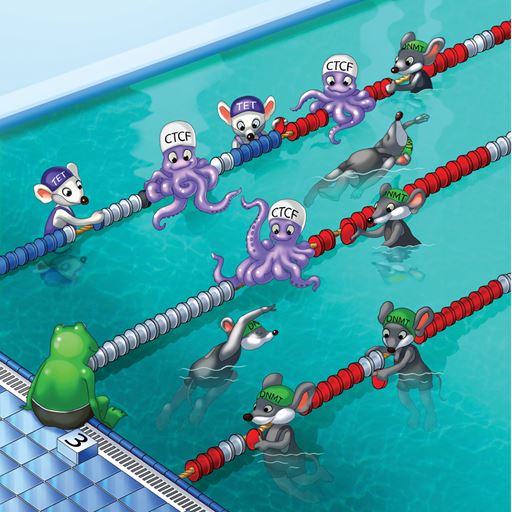How cute mice and octopuses explain complex research
-
Date
Fri 17 May 19

Research by Essex genomics experts is featured on the front cover of prestigious journal Genome Research – for the second month running.
The cover of the May issue shows a cartoon which conveys in a simple and fun way a complicated mechanism of epigenetic regulation – a type of regulation of gene activity that does not involve changes in the DNA sequence – which is described in work conducted by scientists at Essex and the German Cancer Research Center.
Whilst the experiments in embryonic stem cells were conducted in Germany, the computational analysis and modelling was carried out in Essex by a team led by Dr Vladimir Teif, from our Genomics and Computational Biology Group.
The cartoon shows mice having fun in a swimming pool where they are changing coloured buoys. The cartoon characters represent biological molecules and the buoys represent different chemical DNA modifications. The octopuses representing molecules called CTCF create boundaries stopping the spreading of DNA modifications.
The image was created by artist Yana Savinich who is part of a scientific outreach project of Dr Teif’s lab devoted to the use of augmented reality (AR) - a technology that superimposes a computer-generated image on a user's view of the real world - in education.
Complicated scientific concepts can be animated with AR, helping to visualise molecular structures and move them around to understand their action. This idea is used in an education project supported by the Royal Society in collaboration with Dr Mari Chikvaidze in Claremont High School, in Brent, London.
Dr Teif said: “We are so pleased research involving the Essex genomics group has again been featured on the front cover of Genome Research, which is one of the top journals in the field of genomics.
“Genome packing in three dimensions is traditionally represented by spaghetti-like pictures, whereas this swimming pool analogy offers a fresh perspective. If you can visualise something you can better understand it. It’s even better if you can visualise it in augmented reality and be able to play with it.”
.jpg?mh=500&mw=500&hash=6568B6C9CCF5290A596BEF6678B6AD0E)



